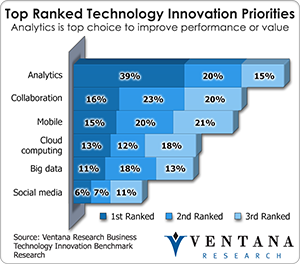When it comes to today’s customers, companies have to be  smart if they are going to anticipate and meet new customer expectations. These days IBM talks about doing most things in “smart” ways. Recently I was briefed on IBM’s Smart Customer Analytics, but it took me quite a while to find information about it on the company’s not-so-smart website. Surprisingly since business analytics is so important to IBM current and ongoing investments and is the top ranked technology innovation priority in 39 percent of organizations according to our benchmark research.
smart if they are going to anticipate and meet new customer expectations. These days IBM talks about doing most things in “smart” ways. Recently I was briefed on IBM’s Smart Customer Analytics, but it took me quite a while to find information about it on the company’s not-so-smart website. Surprisingly since business analytics is so important to IBM current and ongoing investments and is the top ranked technology innovation priority in 39 percent of organizations according to our benchmark research.
IBM’s recent history in analytics began with its acquisition of Cognos, and it has gone on acquiring analytics vendors, including SPSS, Unica, Tealeaf and many others. Through these purchases IBM has assembled a comprehensive set of capabilities to support the complete customer life cycle, which it defines as acquire, grow and retain. At the acquire stage the products support granularity of customer segmentation, which smart companies can use to ensure that customers receive the right messages through the channel of their choice. To grow the customer base it supports analysis of customer issues, sentiment and trends to support cross- and up-selling, and the collection of all customer data to create a 360-degree view of the customer. To support customer retention IBM offers predictive analysis to identify customers at risk of defection and suggest actions to address issues, as well as to generate insights to define and execute an ongoing customer engagement strategy.
How does IBM support all these activities? The answer starts with data, which is at the heart of customer analytics. IBM segments it into descriptive data (such as name, address and other attributes), behavioral data (transactions such as orders and payments), interaction data (including email messages, chat scripts, Web streams and CRM notes) and attitudinal data (such as customer feedback, market research and social media comments). Eventually companies need to bring together, rationalize and analyze all customer data, from any source, type (structured, unstructured and event-based) or time frame; the more they include, the fuller their customer view will be. Customer analytics has tools that extract data from multiple data sources, an information management platform that brings the data, predominantly structured data, text and social media, together, and makes it available for the analytics platform. These requirements and steps for customer analytics requires integrating all of this information requires big data technology that IBM has advanced as my colleague notes but will need to be further integrated into its existing customer focused efforts and further embrace its current big data analytics that we have assessed. This includes tools that support data and text mining, business rules management, entity analytics, sentiment analysis and business intelligence; together they help companies carry out predictive modeling, sentiment analysis, forecasting and simulation, social analytics, and customer feedback analysis. The results are shown in scorecards, dashboards and reports that support the latest visualization techniques, and which support real-time decision-making.
Through the process of acquiring technology vendors to support business analytics, enhancing their products, developing new capabilities and integrating the products, IBM has created an impressive set of capabilities. However, it is missing speech analytics, which my research into customer analytics shows can be a prime source of customer insights. These days most companies have at least one contact center, and almost all centers record some if not all calls. These contain valuable information about customers, including product and service issues, sentiment, hot issues, trends and predictive behaviors. To obtain a full 360-degree customer view, companies thus need to include analysis of these recordings. In another area, IBM’s work with Watson, its natural-language processing technology, that my colleague has assessed in conjunction with customer analytics could make customer analytics smarter. By using Watson’s capabilities to find and integrate other customer data into a fuller, richer customer view, it could guide actions with even greater detail.
There is no denying that customers have changed their purchasing and communication habits. To keep up, companies need the fullest customer view they can obtain. IBM’s smart customer analytics goes a long way toward meeting these needs. I recommend that companies evaluate how these tools can help them improve all aspects of the customer journey and experience.
Regards,
Richard J. Snow
VP & Research Director










